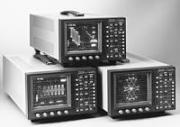
The 1740A/1750A/1760 Series make up a family of analog video waveform/vector monitors with progressive features in support of today's demanding television environment.
Each model in the series provides improved video performance and ease of operation and incorporates application-specific features. The family includes the 1740A Series composite analog waveform/vector monitors, the 1750A Series, which adds SCH and color frame verification capabilities, and the 1760 Series for mixed-format component/composite applications. (While the 1740A and 1750A do provide basic component waveform monitoring capabilities with parade and overlay displays, only the 1760 provides full component monitoring capabilities.)
Each series includes models for NTSC, PAL, or dual-standard NTSC/PAL operation. For NTSC models, the last digit of the model number is '0' (1740A, 1750A, or 1760); '1' for PAL (1741A, 1751A, or 1761); and '5' for dual-standard NTSC/PAL (1745A, 1755A, or 1765).
The family features a common, straightforward operator interface, allowing the operator to take immediate advantage of the instrument's extensive feature set. Each operating mode provides a full set of operating controls, clearly labeled and within easy reach. Key controls are always available, with bezel buttons and knobs identified by intuitive on-screen labels.
Selection Guide
| Product Applications | 1740A Series | 1750A Series | 1760 Series |
|---|---|---|---|
| Composite or Component Waveform Monitoring | X | X | X |
| Composite Vector Display | X | X | X |
| Picture Display | X | X | X |
| Stereo Audio Display | X | X | X |
| Time Code Phasing and Amplitude | X | X | X |
| SCH and Color Framing Display |
| X | Opt. SC |
| Component Vector, Lightning, Diamond, and Bowtie |
|
| X |
All family members provide the following standard features:
Eight Video Inputs eliminate the requirement for external input selectors, reducing total system cost in many applications. Since all eight inputs are connected directly to the instrument, signals may be paraded, overlaid, or displayed in comparison modes not normally available with a simple external switcher.
Waveform monitoring is analog for maximum waveform fidelity. There is no digital processing of the displayed signal. The selected input may be displayed in one- or two-line or one- or two-field sweeps on a continuous basis or identified lines of any field may be selected and displayed. Multiple inputs may be displayed at the same time or multiple filters may be applied to one input for signal analysis. Time and voltage cursors may be activated and positioned for reference or measurement.
Composite Vectorscope functions demodulate and display the color components of the NTSC or PAL signal. A microprocessor-controlled phase shifter provides accurate vector positioning and eliminates readjustment when switching between internal and external reference modes. Phase and amplitude cursors with on-screen readout allow system setup to reproduce specific chroma values and specific colors when luminance is similarly set using the waveform-display voltage cursors.
A Picture Monitor mode is provided for easy signal identification. This is particularly useful when the instrument is used to monitor many sources, as in a production suite or outside production vehicle. In waveform or vector line select mode, a line bright-up marker in the picture display identifies the selected line.
Stereo Audio Amplitude and Phase are monitored using a calibrated L/R Lissajous display. The operator can quickly see that the program audio will be properly r
Tektronix 1740A